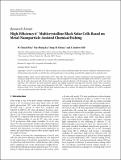High-Efficiency 6′′ Multicrystalline Black Solar Cells Based on Metal-Nanoparticle-Assisted Chemical Etching
Author(s)
Hsu, W. Chuck; Lu, Yen-Sheng; Chyan, Jung-Yi; Yeh, J. Andrew
DownloadHsu-2012-High-Efficiency 6 ''.pdf (4.248Mb)
PUBLISHER_CC
Publisher with Creative Commons License
Creative Commons Attribution
Terms of use
Metadata
Show full item recordAbstract
Multicrystalline silicon (mc-Si) photovoltaic (PV) solar cells with nanoscale surface texturing by metal-nanoparticle-assisted etching are proposed to achieve high power efficiency. The investigation of average nanorod lengths from 100 nm to 1 μm reveals that the Si wafer decorated with 100 nm thick nanorods has optical reflection of 9.5% inferior than the one with 1 μm thick nanorods (2%). However, the short nanorods improve the doping uniformity and effectively decrease metal contact resistance. After surface passivation using the hydrogenated SiO[subscript 2]/SiN[subscript x] (5 nm/50 nm) stack, the minority carrier lifetime substantially increases from 1.8 to 7.2 μs for the 100 nm-thick nanorod solar cell to achieve the high power efficiency of 16.38%, compared with 1 μm thick nanorod solar cell with 11.87%.
Date issued
2012Department
Massachusetts Institute of Technology. Department of Mechanical EngineeringJournal
International Journal of Photoenergy
Publisher
Hindawi Publishing Corporation
Citation
Hsu, W. Chuck et al. “High-Efficiency 6′′ Multicrystalline Black Solar Cells Based on Metal-Nanoparticle-Assisted Chemical Etching.” International Journal of Photoenergy 2012 (2012): 1–7.
Version: Final published version
ISSN
1110-662X
1687-529X